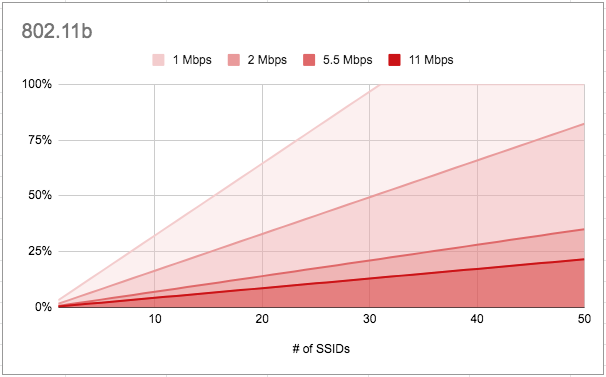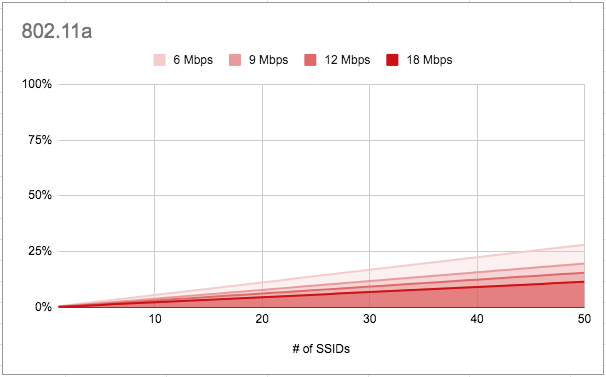Lowest Basic Rate vs Number of SSIDs
Andrew von Nagy of Revolution Wi-Fi created the SSID Overhead Calculator which demonstrates very well how overhead from beacon traffic can affect your Wi-Fi network. Beacons are transmitted at the lowest basic rate and alone have the potential to eat up a significant amount of your precious air space.
Let’s take a look at the output of Andrew’s calculator in a more visual way.
Figure 1 shows a comparison of channel utilization of 802.11b configured with a basic rate of 1, 2, 5.5, and 11 Mbps. If you have 1 Mbps configured as a basic rate, it takes just 32 SSIDs to consume all of the airspace in a given channel. Even at 16 SSIDs, half of your airspace will go to beacons alone. Increasing your lowest basic rate makes a huge impact on utilization by beacon traffic.

Figure 2 shows a comparison of channel utilization of 802.11a beacons configured with a basic rate of 6, 9, 12, and 18 Mbps.

Based on the charts above, one might be tempted to conclude that as long as we configure our lowest basic rate appropriately, the number of SSIDs used are no longer an issue. This is a dangerous assumption.
It is indeed a good idea, and highly recommended, to appropriately configure your lowest basic rate to the highest that your network can reliably support. You might base this upon the client devices you must support and the required coverage cell size.
However, it is still considered a best practice to use only as many SSIDs as you really need. It is important to remember that every SSID in a given channel and Basic Service Area (BSA), whether they belong to you or a neighbor, whether they are coming from one or multiple APs, must transmit beacons. Sadly, we do not have much control over our neighbors’ networks short of making tactful suggestions. Just because we may have our lowest basic rate configured appropriately and only as many SSIDs as truly required doesn’t mean that all of our neighbors will follow the same guidance.
Even if you are fortunate enough to be in an area with very few other Wi-Fi networks within range, unnecessary beacon traffic means less airtime available to your clients.
If a requirement for separate SSIDs exists, then you do what you have to do. Reasons may include supporting a guest network or other varying levels of security requirements. A common reason of the past was to have an SSID per user VLAN, but these days, it is much easier to minimize the number of SSIDs you are broadcasting with Network Access Control (NAC) solutions that can dynamically assign VLANs.